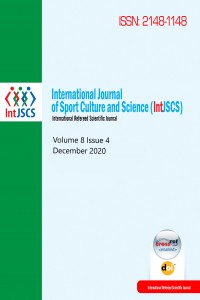Öz
Kaynakça
- 1. Gogunov, E. & Martyanov, B. (2004). Psychology of physical education and sports: Textbook. manual for students. higher ped. studies, institutions. 2nd revised edition. Moscow: Academy Center.
- 2. Jowett, S., & Cockerill, I. (2003). Olympic medallists' perspective of the athlete-coach relationship. Psychology of Sport and Exercise, 4(4), 313-331.
- 3. Morris, D. (2007). Gestures and behavior. Introduction to body language. Sofia: Ciela.
- 4. Pease, A. & Pease, B. (2003). Body Language: How to Read Others' Thoughts by Their Gestures. Buderim: Pease International.
- 5. Peltekova, I. (2013). The purpose of non-verbal communication in the training and competitive process of basketball. Collection of scientific articles - Volume 2, Second book. Gabrovo: EX-Press.
- 6. Rumenchev, V. (2006). Non-verbal communication in public speech and business communication. Sofia: St. Kliment Ohridski.
- 7. Shipunov, S. (2003). On the same wave with the interlocutor. Secrets of conversation. Moscow: Ecopress.
- 8. Weinberg, R. S. & Gould, D. (1995). Leadership. Foundations of sport and exercise psychology, 4th Ed. Champaign: Human Kinetics.
- 9. Zaberska, Y. (2009). Morality and sports. Personality. Motivation. Sports. Volume 14. Sofia: National Sports Academy Press.
Öz
Communication between people has existed since the very beginning of human civilization. As an extremely complex process, it continues to be difficult to define in a way that can cover all its aspects that it compiles and generates.
Whether verbal or non-verbal - communication expresses every change that occurs between individuals in the process of their communication. Communication is an art through which we successfully share significant and important information with each other and as such it exists in all spheres of our lives, incl. and in sports. It is the way coaches pass on their knowledge, skills and experience; through which they want to motivate and stimulate the teams; through which they provide information that will allow athletes to train effectively, productively and continuously improve and refine their performance. Whether the interpersonal "coach-athlete" relationship is based on communication with words, gestures, facial expressions or body language, they are based on communication, i.e. it is both verbal and non-verbal.
This article aims to show the important aspects of non-verbal communication and its application in interpersonal relationships between coaches and athletes, based on the importance of non-verbal communication and the requirements for its effectiveness. The reasons for choosing this topic are based on the statement that in the interpersonal relationship "coach - athlete" and sports in general, non-verbal communication has not only a significant application in this relationship, but is also a strongly dominant communication process between teams and their coaches.
Anahtar Kelimeler
non-verbal communication interparsonal relationships coach athlete sport activity
Kaynakça
- 1. Gogunov, E. & Martyanov, B. (2004). Psychology of physical education and sports: Textbook. manual for students. higher ped. studies, institutions. 2nd revised edition. Moscow: Academy Center.
- 2. Jowett, S., & Cockerill, I. (2003). Olympic medallists' perspective of the athlete-coach relationship. Psychology of Sport and Exercise, 4(4), 313-331.
- 3. Morris, D. (2007). Gestures and behavior. Introduction to body language. Sofia: Ciela.
- 4. Pease, A. & Pease, B. (2003). Body Language: How to Read Others' Thoughts by Their Gestures. Buderim: Pease International.
- 5. Peltekova, I. (2013). The purpose of non-verbal communication in the training and competitive process of basketball. Collection of scientific articles - Volume 2, Second book. Gabrovo: EX-Press.
- 6. Rumenchev, V. (2006). Non-verbal communication in public speech and business communication. Sofia: St. Kliment Ohridski.
- 7. Shipunov, S. (2003). On the same wave with the interlocutor. Secrets of conversation. Moscow: Ecopress.
- 8. Weinberg, R. S. & Gould, D. (1995). Leadership. Foundations of sport and exercise psychology, 4th Ed. Champaign: Human Kinetics.
- 9. Zaberska, Y. (2009). Morality and sports. Personality. Motivation. Sports. Volume 14. Sofia: National Sports Academy Press.
Ayrıntılar
| Birincil Dil | İngilizce |
|---|---|
| Konular | Spor Hekimliği |
| Bölüm | Makaleler |
| Yazarlar | |
| Yayımlanma Tarihi | 13 Aralık 2020 |
| Yayımlandığı Sayı | Yıl 2020 Cilt: 8 Sayı: 4 |

